10 Feb The Oldest Story in the World
Ancient story of Orion and the Pleiades may predate human migration out of Africa.
New astronomical calculations seem to explain the similarities between stories of the night sky as depicted by isolated cultures. Both Aboriginal Australian and Greek Mythology stories depict variations on the story of the Pleiades (The “Seven Sisters”) constellation being pursued by Orion the Hunter, resulting in the loss of one of the sisters. Nowadays, even on a clear night, the large majority of people can only count six stars with the naked eye. How, then, could two cultures that developed independently for about 50,000 years, have similar folklore of this celestial object? Intriguingly, it may be that this story in fact originated with some of the first Homo Sapiens before our migration out of Africa some 100,000 years ago, being adapted with variations into each culture over time.
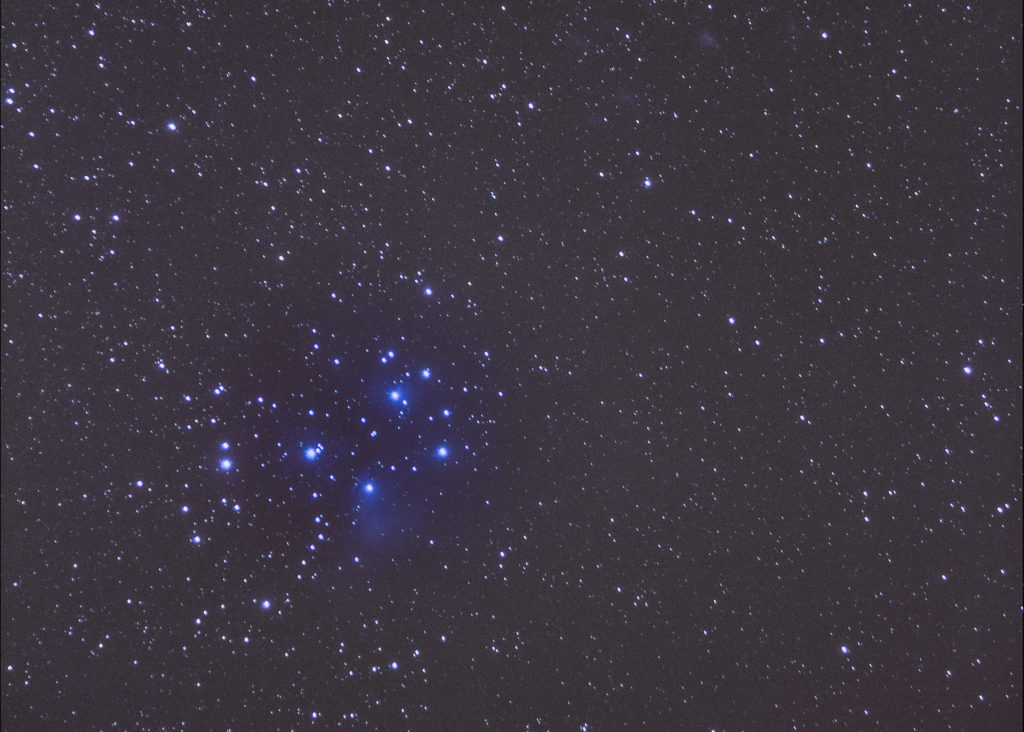
A photo I took of the Pleiades in 2015 from near Barcelona. In fact, it is the sum total of dozens of photos and calibration frames that were digitally combined to reveal more detail. The stars appear slightly elongated due to the rotation of the Earth during the exposures.
Today I have a unique opportunity to talk about two of my favourite subjects: astronomy and anthropology. One of the most impressionable memories I have as a child is looking up at the stars while out camping with my family. My mother would tell us the Legend of the Big Dipper while we sat around the campfire on a cool summer night. For us, this involved a young girl who went out to find water for her sick mother in a drought-stricken village only to find that others needed her help along the journey. Her kindness pays off and the dipper continuously refills to provide water for everyone.
Big Dipper story
At the risk of going down a little rabbit hole, I must say that writing this blog has made me curious as to where the Big Dipper story in fact originated. The reader of the story in the above YouTube video, Jenni Cargill-Strong, mentions at the end that it is a folktale from Europe, which does seem quite probable to me given my European roots. Something that perked my attention though is how, well, the only use I ever remember for the word ‘dipper’ is from this old story. We would have always called it a pot or a pan, or perhaps a ladle. Other people online have attributed the story to Carolyn Sherwin Bailey, a 19th and 20th century American writer, but in fact she adapted it from “an old legend”. You can find most of her writings archived on Project Gutenberg.
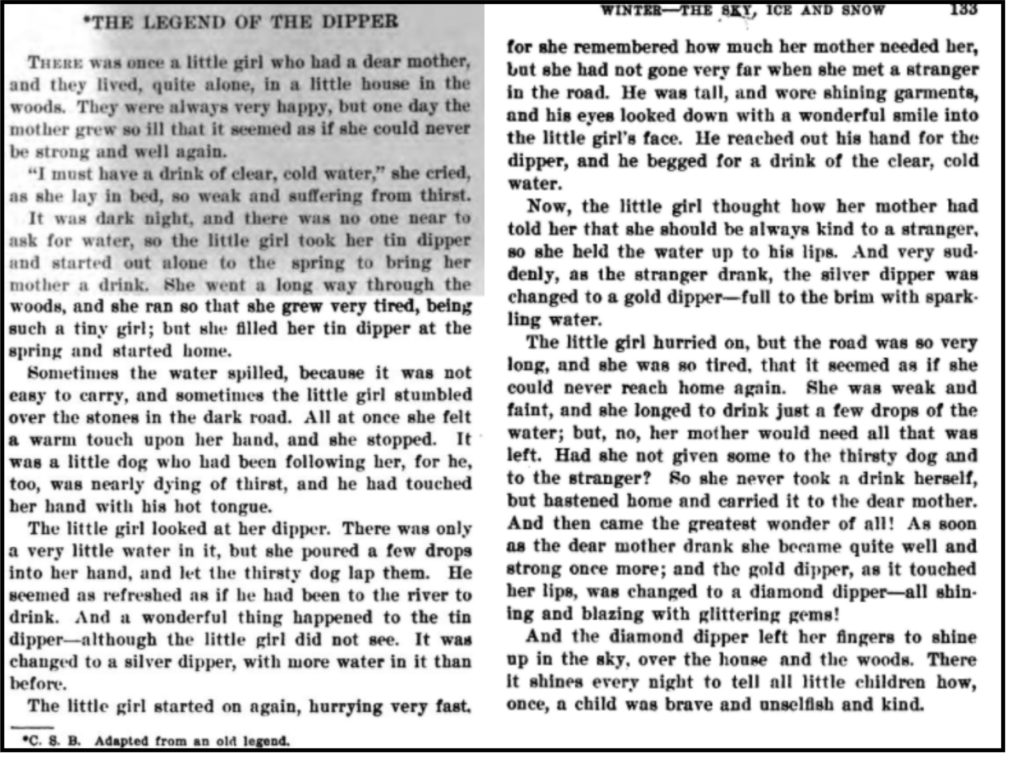
The Legend of the Dipper (from Project Gutenberg).
When I look a little into the etymology of the word “dipper”: https://www.etymonline.com/word/dipper
it indicates that the word is mainly American English, as is the asterism of the Big Dipper (it’s not an official constellation, but part of the Great Bear, Ursa Major). In Britain it is known as The Plough, a wagon, or Charles’s Wain (related to Charlemagne). So, it seems that any association with it being a dipper, or ladle had come from post-colonial America. Given that the legend of the Big Dipper doesn’t seem to have been brought by the first English colonists, from where did the term originate and how long ago? No matter, given the many different names for it (The Plough, Great Bear, Charles’s Wain), this particular story of the Big Dipper doesn’t seem to be any more than just a few hundred years old, as far as I can tell. But there is another legend一let’s call it “The Legend of the Missing Sister”, that may be much, much older, indeed.
Seven Sisters
When I was young we were never told this specific story of one of the Seven Sisters going missing. I suppose that this is because it is a late season celestial object, and we didn’t do much camping in the fall and winter in chilly Canada. I certainly knew of the Pleiades, as it was still quite visible from the snowbank in the backyard of my small city. But, of course, I could only ever count six stars, never seven.
As I grew older, I always attributed this to the atmospheric seeing conditions, light pollution, or just imperfect vision. Anyway, my favourite view of it has always been with binoculars or a small telescope, as you can clearly see dozens of twinkling stars. So, it never really seemed like a big deal to me that there was a ‘missing’ star. In any case, I wasn’t particularly into mythology, folklore, or history at the time; rather, I was intrigued by the enormous sizes of, and distances to, the stars; and how the sun itself is a star, and that there may actually be other solar systems out there with unique worlds of their own.
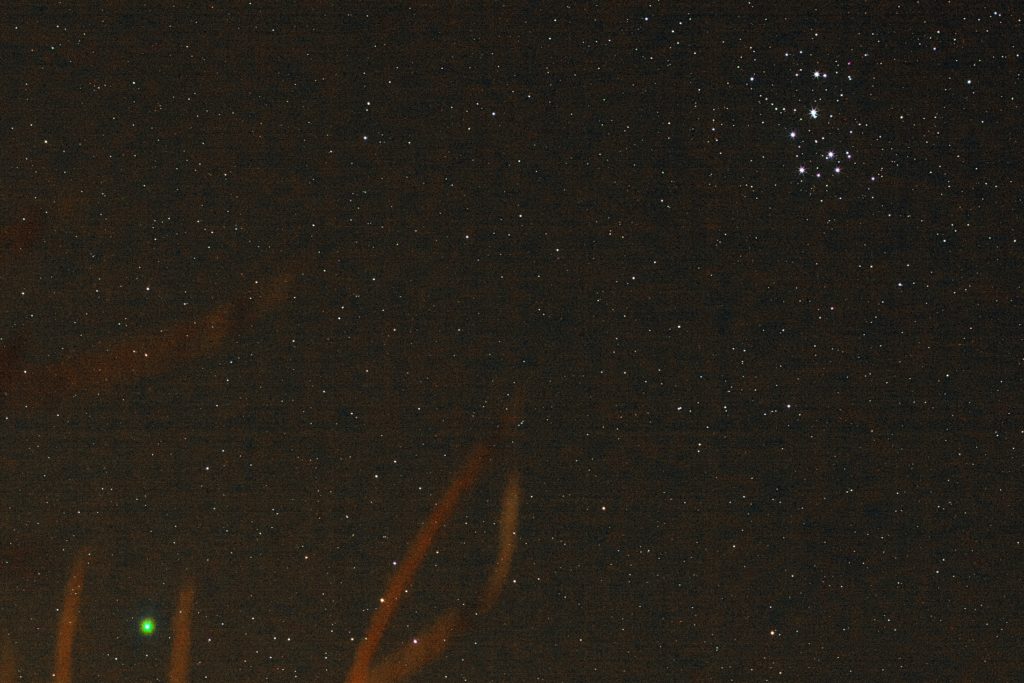
A photo I took of the Pleiades in 2014 from my backyard in Catalonia. The seven sisters can be seen in the upper right. In the lower left we can see Comet C/2014 Q2 (Lovejoy). Also in the lower left you can see the branches of our Japanese maple tree, which unfortunately seems to have been either a causality of climate change, or the result of its naïve owners. :-/ For a sense of scale: due to the speed of light being what it is, we see the Pleiades as they were 444 years before the photo was taken, Comet Lovejoy as it was 43 minutes before the photo, and the tree branches, yeah, well, we see them as they were just 10 nanoseconds into the past (about 3 m away). Nerd alert! Hence, strictly speaking everything we see actually did happen some time in the past. Astronomy opens your mind to that fact.
If I had looked a little deeper into the mythology of the constellations, I would have found out that in Greek Mythology一the typical constellations identified in Western civilization, the zodiac, etc.一the Pleiades were the daughters of the Titan deities Atlas and Pleione. Atlas, it was said, being forced to hold up the sky, could not protect his daughters from Orion the Hunter, who can be seen rising in the night sky earlier after sunset each evening in the boreal fall and winter, seemingly pursuing the Pleiades, who always rise earlier.
Variations of this story are seen throughout Western culture, having been passed on orally with imperfect fidelity一indeed, some cultures do not tell the same story at all, such as in the Hindu tradition where the star cluster is depicted as a god of war. In fact, given the physical separation of cultures over the expanse of time, it is hard to imagine there wouldn’t be significant variations of the tale.
Curiously, two Australian astronomers, Ray Norris, and Barnaby Norris, after studying the literature written on Aboriginal Australian folklore, have found striking similarities between their stories of these stars and those of Greek mythology. Notably, both cultures depict a missing sister, one of the Pleiades sisters who had been pursued by Orion (though, in this case, Orion is not a Hunter, but the constellation corresponds to three boys一the three stars of the “belt” of Orion). Citing this similarity, the authors hypothesize that over the tens of thousands of years of human history, toward the end of the period of Homo Sapiens’ migration out of Africa, perhaps one of the seven visible stars of the Pleiades has slowly become optically less visible, leading to the plot of this ancient story being invented to explain why.
The comparison between cultural stories of the night sky is fascinating because, as far as we know, there had been no contact between Europeans and Aboriginal Australians until Imperial Britain’s invasion devastated their cultures beginning with the First Fleet in 1788. There is probably a lot written on this that makes it an obvious point, but it seems to me that we can safely assume that the Greek story did not usurp the Aboriginal one post-colonization. In order for that to have had occurred we would be required to explain why the Aboriginals would have subsequently changed the central antagonist(s) of the story一Orion the Hunter to 3 Young Men.
Ok, in fairness, perhaps we can entertain the possibility that they had been told the story by the British, but already had had an association for the 3 stars in the belt of Orion (3 young men). Or maybe there was simply a significant language barrier. However, I would be very skeptical of this. I doubt that lecturing the indigenous tribes on ancient Greek mythology of the night sky was one of the first things on the colonisers’ agendas. Suffice it to say, it seems very likely that each culture developed its own myths independently. That being the case, we are left to explain how and why two isolated cultures could have such similar celestial lore. Could we even quantify how probable it would be for it to be pure coincidence? Or, could it be that this story was brought with the Aboriginal founders of Australia over 50,000 years ago? Given that the legend was also brought northwest into Greece, could it even predate humanity’s great migration out of Africa, as much as 100,000 years ago? How could we find out?
The authors of this study explain the missing star by positing that one star has been slowly becoming less visible over the course of human time. By using precise modern astronomical data of the Pleiades, computer modeling, and knowledge of the physiology of the human eye, they report that if you could wind back time a few hundred thousand years, it would have been easier to see seven stars, not six. Over time, and from our perspective on Earth, Pleione is actually moving closer to Atlas, making them seem increasingly like a single star.
Modern Astronomy Weighs In
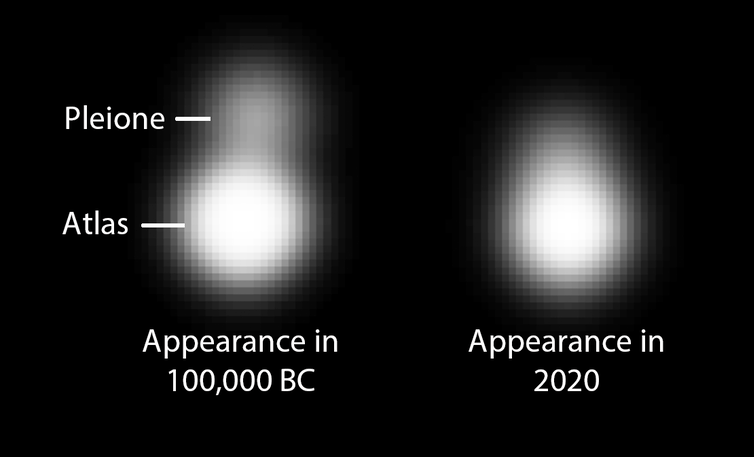
Comparison of how the separation of Pleione and Atlas may have looked 100,000 years ago一as humans were beginning to migrate out of Africa一to nowadays where they almost seem to be a single star (from Norris and Norris, 2020).
So, what are the Pleiades in the modern scientific sense? The Pleiades is an open cluster of about 800 massive, middle-aged, but short-lived, B-type blue stars some 444 light years from our Solar System. The entire cluster is moving through the galaxy as a group, and is presently passing through a region of denser-than-normal interstellar dust; the dust being beautifully illuminated by the reflection of light from the stars. The stars of the Pleiades are orbiting one another (technically, they orbit a common centre of gravity) in what is sometimes poetically referred to as a ‘cosmic ballet.’
Everything is in motion relative to everything else. We see the stars and planets rise and set as the Earth spins. We see the time of those risings and settings change throughout the seasons due to the Earth’s motion around the Sun. We see the other planets move in their orbits over months and years, making them change positions slowly relative to the background stars. But, even those stars are not fixed points. They are all affected by the gravity of every other celestial body; and the closer they are, the more gravitational attraction they experience. So, the Pleiades, being relatively close together feel the intense gravity of each other and move accordingly.
Astronomers measure apparent stellar motions in the sky relative to the Sun’s position compared to the background of more distant stars. We call that a star’s proper motion to distinguish it from its apparent motion due to the rotation and revolution of the Earth, for example. Astronomers have made enough observations of the Pleiades over the years now that we now have good constraints on where they would have been relative to one another in the past. In other words, knowing the observed motions一which have been greatly improved using data from the Gaia space telescope一astronomers can create computer models to tell us where they had been in the past. That’s exactly what the authors of their soon-to-be-published paper did, as you can read in their corresponding article, and a preprint of the scientific paper.
In their research, the authors also explore the literature on the physiology of vision. As I mentioned above, when I was a young astronomy enthusiast, I always explained the difficulty of seeing seven (or more) stars in the Pleiades to either the observing conditions, or just limitations to what the typical human eye can perceive. I will note that in researching for this blog, I found several instances in books, which state that some people claim to be able to see up to 14 stars with the naked eye. If so, this complicates the relatively neat story outlined here. One possible explanation could be that seeing so many stars is only possible at high altitudes in near ideal conditions. Still, this being the case, there is no reason to think that the majority of migrating humans out of Africa visited high altitudes to do any detailed scientific observations of the Pleiades. They would have more likely migrated close to sea level where there was more access to food一and by its nature where the atmosphere would be more of an impediment to seeing the stars.
In terms of spatial resolution (how easy it is to resolve two objects), a familiar example occurred in December 2020: the Great Conjunction of Jupiter and Saturn. At their closest apparent separation in the sky, they seemed almost like a single bright object, but if you looked closely you could see both. Aside from that, there is also the eye’s sensitivity to brightness and how vision differs in faint light because of its reliance on rods as opposed to cones. For instance, physiologists define a glare factor that quantifies how a dimmer object can be washed out by a nearby brighter one. Imagine two people standing at the other end of a field at night. One is holding a small flashlight, when the other suddenly turns on a bright, sports stadium floodlight. Even though the lights may be sufficiently separated to be easily resolvable一and photographic analysis would probably be able to tease out the dimmer light一to your eye, you would just perceive one bright flood light.
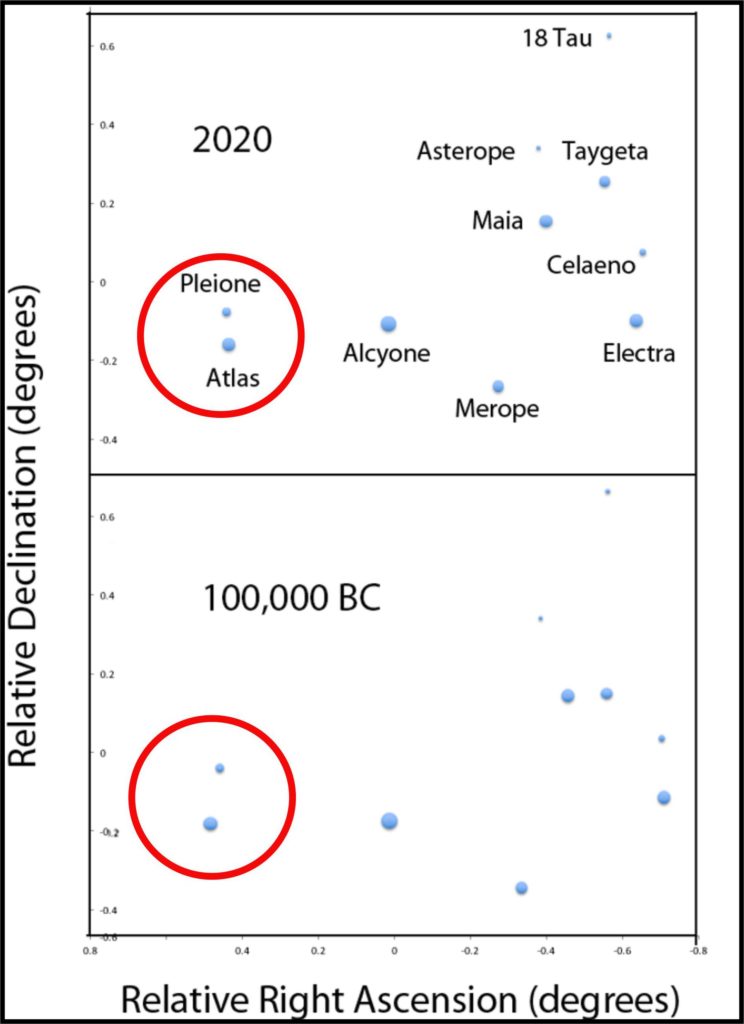
Computer model results showing the calculated proper motions of stars in the Pleiades. Note the change in relative positions of Pleione and Atlas (red circles) (modified after Norris and Norris, 2020).
How long can we remember?
Could this really be the oldest story known? Could an ancient story be so compelling that its central plot has been passed on orally over tens of thousands of years, across continents? At the outset it seems implausible, especially given the familiarity of how easily digital information can veer from the original nowadays. At the outset, there would appear to be no way the details could have been passed on for so many years with fidelity by word of mouth.
However, in this case, the exact details of the narrative are not necessary to make the case; we just note the similarities in the overall plots. As the authors of this investigation point out, there are four principal similarities between the Greek and Aboriginal Australian mythologies:
- Both cultures identify the Pleiades as a group of seven young girls or sisters, even though most humans can only see six stars without the aid of binoculars or a telescope.
- Both cultures have stories to explain the missing star.
- Both identify some or all of the stars of the constellation Orion as a hunter, young man, or group of three young men.
- Both depict the assailant(s) as attempting to catch or rape the sisters.
A thought experiment: take two groups of wholly independent peoples, and let them look up at the sky and create their own stories of the stars from scratch. What are the chances that their stories would coincide?
Yes, there are certain celestial objects that stand out particularly well amongst the background stars. The Pleiades in particular are so tightly packed that it is hard to imagine anyone not weaving them in some type of story. Orion also has some very prominent stars, making them an easy choice for pattern-seeking Sapiens’ brains with the time and luxury to look skyward and wonder.
When humans first began to control fire, we were able to digest food more easily, drawing more nutrients, and brain power. It gave us protection from the cold, and from predators, and it allowed us to stay up long past the sunset, warm by the fire, collecting our thoughts and crafting stories with our newfound language skills.
The stories as told by both cultures have another thing in common: they are emotional, dramatic stories involving enemies and the loss of a loved one. The central themes of these Greek and Aboriginal Australian stories (man sexually attacking woman) were probably, and regrettably, a fearsome part of Hobbesian hunter gatherer societies. Considering this point, it now seems to me rather plausible that such an impactful and, thus memorable narrative arc could indeed have been carried over for many generations. And remember, it’s not like there were millions of us jet-setting around the globe, gazing into our smartphones.
Back then we lived in distinct small bands or tribes. All that would be needed to enhance preservation of any given myth would be a dramatic, emotional narrative一that probably depicted a real event(s)一could be re-told from time to time. I don’t think that’s too hard to believe.
Alas, in scientific inquiry we are compelled to accept a degree of uncertainty in our knowledge. Save for some highly unlikely smoking-gun archaeological evidence, we just might have to be satisfied never fully knowing for sure. At a time in our history when our society seems to be ever more politically fragmented, there is something reassuringly optimistic about being united in our humanity across aeons of time. Have a great day, fellow humans!

